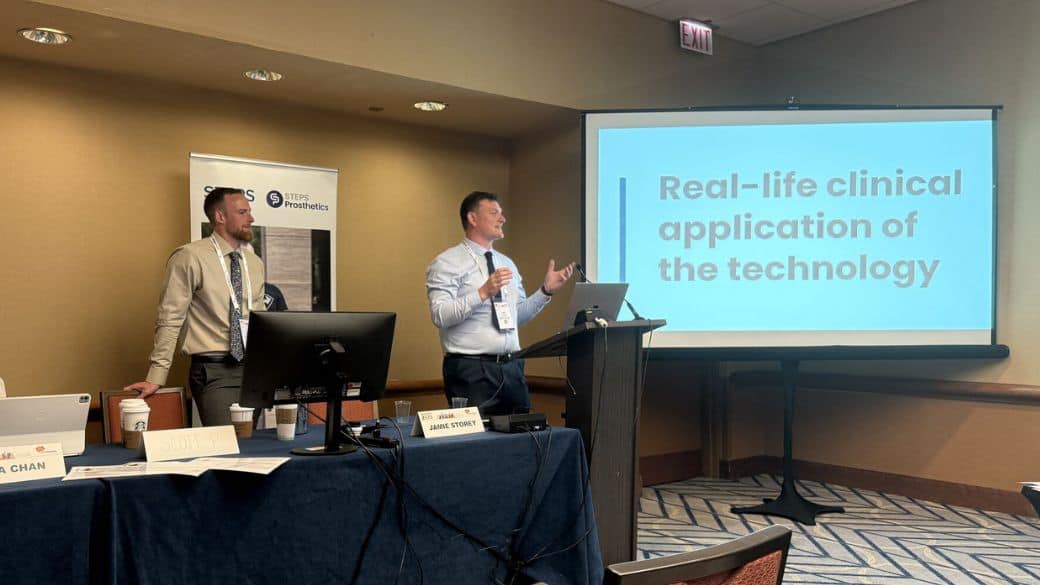Our team swapped the Steel City for the Windy City this week as we headed across the pond to present at RehabWeek 2025 in Chicago, US.
RehabWeek is an international conference attended by rehabilitation, medical, and engineering specialists from across the globe, meeting to share ideas about rehabilitation technology. The primary focus is to enable a collaborative approach between those designing and building the devices, and the clinicians using them with their patients.
STEPS’ Clinical Director, Toria Chan, along with Lead Physiotherapist, Jamie Storey and Specialist Rehabilitation Physiotherapist, Scott Pearson presented on “integrating lower limb rehabilitation technology to meet the diverse needs of clients in an in-patient complex trauma setting.” The aim of the session was to explore the practicalities and considerations when choosing and integrating lower limb rehabilitation technology into clinical practice.
In this interactive session, they were joined by representatives from several leading global rehab technology companies who brought along their innovative products to demonstrate to delegates and provide them with a unique opportunity to gain some hands-on experience:
- Anna Poswiata, Clinical Manager, EGZOTech (Poland)
- Val Brown, US Sales Director, Strolll® (US)
- Kong Keun Cho, Chief Marketing Officer, ExoAtlet (Los Angeles, US)
- Stephen Ruffle, Commercial Director, Thor Assistive Technologies (UK)
Case Studies using Rehabilitation technology
Using three different client case studies, the team explored their individual therapeutic needs and goals explaining how the different rehabilitation technologies were used as part of their inter-disciplinary rehabilitation programme. The session included demonstrations of the Bioness L300 Go, a device which re-educates lower leg muscles with electrical stimulation for better walking control during rehabilitation therapy, Luna EMG a powered robotic device for upper and lower limb rehabilitation, ExoAtlet II the latest powered lower limb exoskeleton with integrated FES, ExoMotus ™ M4 an institutional training powered exoskeleton for safe walking and Strolll® a revolutionary all in one digital therapeutic software solution for AR glasses.
Case studies varied and included client A who presented with a transtibial amputation, prior to client A’s accident, they worked in a physically intensive role and wanted to return to driving and be able to complete all care needs independently. The team shared how despite the client’s initial reluctance to use rehabilitation technology, they used the Bioness L300 and Luna EMG, along with the MindMaze MindMotion®GO at STEPS to develop muscle strength, proprioception and modulation, enabling the client to significantly improve their outdoor mobility and stair mobility.
Client B had a stroke, and their rehabilitation aims included to be able to be involved in family orientated activities. They were very keen to engage with all of the rehabilitation technology that STEPS has to offer, including the Exomotus M4, MindMaze MindMotionGO and MindPod. The interactive aspect of using the Strolll enabled them to produce more transferable neuroplastic responses, helping them to achieve all of their goals.
The final client case study, client C focussed on a client with polytrauma injuries including a C2 incomplete spinal cord injury. Prior to the accident they had been very active and had a busy work life. Their initial rehabilitation goals were to be able to sit to stand using a pulpit frame with the assistance of 1 other person, and to be able to walk with a walking stick and close supervision for a distance of 10m indoors. Their use of rehabilitation technology began with using the ExoAtlet II, before progressing onto the Bioness L300 and Strolll simultaneously.
The attendees had the chance to try the technology and apply it to these cases with wider discussion to suggest how the tech could be used to benefit their lower limb rehabilitation.
The RehabWeek 2025 Conference is packed with engineers, academics, clinicians and exhibitors with expertise in rehabilitation who are committed to innovating and developing new technologies and techniques to support individuals affected by serious injury and illness. We are proud to be flying the flag for driving innovation and integration of technology to achieve the best possible patient outcomes on the worldwide stage.
